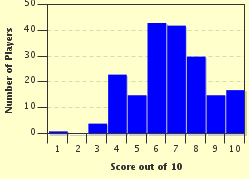Quiz Answer Key and Fun Facts
1. Before I begin with questions specific to the treble clef, tell me what the English translation of the Old French word 'clef' is?
2. It is commonly referred to as the treble clef, but what is the other name for it?
3. One of the mnemonic devices used when learning the notes of the treble clef is a five word phrase that corresponds with each line of the staff from the bottom going up. Which word completes the sentence "Every Good Boy Deserves ________"?
4. As with the naming of the lines on the treble clef staff, a mnemonic device exists for the spaces between the lines (going up). What four-letter word is used?
5. A Major scale is one in which the steps up the scale follow the pattern: whole (step), whole, half, whole, whole, whole, half, where each step is the interval between successive notes of the scale.
What Major scale is shown here on the treble clef staff, requiring no flats or sharps to follow the required pattern?
6. Is the 'Middle C' on a standard 88-key piano notated within the five lines and four spaces of the treble clef staff?
7. The treble clef is used for instruments and voices that commonly sound in a higher register. While all of the instruments seen here, the members of an orchestral string quartet, CAN have parts written in the treble clef, only one of them is wholly written in the treble clef. Which one?
8. The saxophone family consists of multiple instruments ranging from the sopranissimo (highest) down to the subcontrabass. In the middle are the most commonly known alto, tenor and baritone saxophones.
Of these three most common saxophones, which one does NOT use the treble clef in its music?
9. These timpani (or kettledrums) are tunable percussion instruments that use music with treble clef notation.
10. For our final question I have three members of the trumpet family, specifically the piccolo trumpet, the Bb trumpet, and the bass trumpet. Which ones use music notated on the treble clef staff?
Source: Author
reedy
This quiz was reviewed by FunTrivia editor
ralzzz before going online.
Any errors found in FunTrivia content are routinely corrected through our feedback system.

